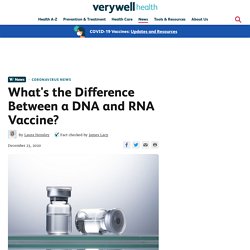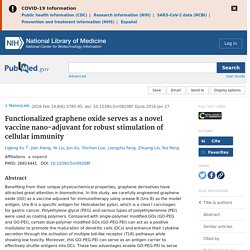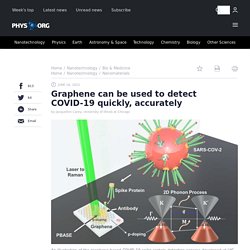

Potential of graphene-based materials to combat COVID-19: properties, perspectives, and prospects. What is a DNA Vaccine? DNA vaccines, which are often referred to as the third-generation vaccines, use engineered DNA to induce an immunologic response in the host against bacteria, parasites, viruses, and potentially cancer.

Image Credit: Billion Photos/Shutterstock.com Traditional vaccines The vaccines that are currently available to the global population include those for measles, mumps, rubella, seasonal influenza virus, tetanus, polio, Hepatitis B, cervical cancer, diphtheria, pertussis as well as several other diseases that are endemic to certain regions of the world. Magnetic properties of graphite oxide and reduced graphene oxide - NASA/ADS. Superparamagnetic nanoparticle delivery of DNA vaccine.
The efficiency of delivery of DNA vaccines is often relatively low compared to protein vaccines.

The use of superparamagnetic iron oxide nanoparticles (SPIONs) to deliver genes via magnetofection shows promise in improving the efficiency of gene delivery both in vitro and in vivo. In particular, the duration for gene transfection especially for in vitro application can be significantly reduced by magnetofection compared to the time required to achieve high gene transfection with standard protocols. What's the Difference Between a DNA and RNA Vaccine? Key Takeaways DNA and RNA vaccines have the same goal as traditional vaccines, but they work slightly differently.Instead of injecting a weakened form of a virus or bacteria into the body as with a traditional vaccine, DNA and RNA vaccines use part of the virus’ own genetic code to stimulate an immune response.An mRNA vaccine for COVID-19 co-developed by Pfizer and BioNTech is the first of its kind authorized for emergency use in the United States.

Several other potential DNA and RNA COVID-19 vaccines are in clinical trials, meaning they are an important and promising area of vaccine development. Researchers around the world are working on developing safe and effective vaccines for COVID-19, the disease caused by the novel coronavirus SARS-CoV-2. There are currently several global vaccine clinical trials taking place, including four major trials in the United States. Some of these potential COVID-19 vaccines are RNA and DNA vaccines, which is an emerging area of vaccine development. Magnetofection. Transfection method using magnetic fields Magnetofection is a transfection method that uses magnetic fields to concentrate particles containing nucleic acid and in-utero samples to the target cells of the body.[1] This method attempts to unite the advantages of the biochemical (cationic lipids or polymer atoms) and physical (electroporation, gene gun) transfection methods in one system while excluding their inconveniences (low efficiency, toxicity).

[citation needed] In 1978, Marseille-based OZ Biosciences trademarked in the UK the word Magnetofection.[2](magenti-infection) Principle[edit] Home. Elon Musk’s Neuralink is being outperformed by this Spanish graphene startup. In February, Elon Musk told the world that his brain-computer interface company Neuralink had wired up a monkey to play video games with its mind.

Unsurprisingly, given the US billionaire specialises in viral moments like these, the announcement made a splash across the world. But one Spanish startup was not so impressed, having spent the last eight years developing a specialised neural implant made of graphene — which it believes vastly outperforms Musk’s Neuralink. “Brain interfaces need to do three things well: record brain signals, stimulate them and then be stable for many, many years in the brain,” says Inbrain cofounder and chief executive Carolina Aguilar.
RESTORING LIVES BY DECODING BRAIN AND NERVE SIGNALS INTO MEDICAL SOLUTIONS. Elon Musk’s Neuralink is being outperformed by this Spanish graphene startup. Smart graphene-brain interface gets funding. The company, whose product is offered as a disruptive system for treating epilepsy and Parkinson's disease, says the funding will enable it to advance first-in-human studies for its flagship product - a less-invasive neuromodulation device for treating neurological conditions using artificial intelligence and graphene electrodes.

"At INBRAIN, our mission is to improve the lives of patients with brain-related diseases, who are forced to live alone with their conditions," says INBRAIN Neuroelectronics Co-founder & CEO Carolina Aguilar. "Less invasive and more intelligent neuroelectronic technologies like ours could provide safer therapies that are upgradable and adaptive in real time, to empower these patients and improve the outcomes that matter to them.
" The company's technology uses graphene, a two-dimensional material made of a lattice of carbon atoms only one atom thick. INBRAIN Neuroelectronics. Designing next-generation neural interfaces with graphene. Brains Improved by Graphene Are on the Horizon. While graphene has been tapped to deliver on everything from electronics to optoelectronics, it’s a bit harder to picture how it may offer a key tool for addressing neurological damage and disorders.

But that’s exactly what researchers have been looking at lately because of the wonder material’s conductivity and transparency. In the most recent development, a team from Europe has offered a deeper understanding of how graphene can be combined with neurological tissue and, in so doing, may have not only given us an additional tool for neurological medicine but also provided a tool for gaining insights into other biological processes. CN112220919A - Nano coronavirus recombinant vaccine taking graphene oxide as carrier. CN112089834A - Preparation and application of pachyman nano adjuvant based on graphene oxide and adjuvant/antigen co-delivery vaccine. Functionalized graphene oxide serves as a novel vaccine nano-adjuvant for robust stimulation of cellular immunity. Benefiting from their unique physicochemical properties, graphene derivatives have attracted great attention in biomedicine.

In this study, we carefully engineered graphene oxide (GO) as a vaccine adjuvant for immunotherapy using urease B (Ure B) as the model antigen. Ure B is a specific antigen for Helicobacter pylori, which is a class I carcinogen for gastric cancer. Recent progress of graphene oxide as a potential vaccine carrier and adjuvant.
Vaccine is one of the most effective strategies for preventing and controlling infectious diseases and some noninfectious diseases, especially cancers.

Adjuvants and carriers have been appropriately added to the vaccine formulation to improve the immunogenicity of the antigen and induce long-lasting immunity. However, there is an urgent need to develop new all-purpose adjuvants because some adjuvants approved for human use have limited functionality. Graphene oxide (GO), widely employed for the delivery of biomolecules, excels in loading and delivering antigen and shows the potentiality of activating the immune system. However, GO aggregates in biological liquid and induces cell death, and it also exhibits poor biosolubility and biocompatibility. To address these limitations, various surface modification protocols have been employed to integrate aqueous compatible substances with GO to effectively improve its biocompatibility.
Toxicity of graphene in normal human lung cells (BEAS-2B) Graphene can be used to detect COVID-19 quickly, accurately. Researchers at the University of Illinois Chicago have successfully used graphene—one of the strongest, thinnest known materials—to detect the SARS-CoV-2 virus in laboratory experiments.

The researchers say the discovery could be a breakthrough in coronavirus detection, with potential applications in the fight against COVID-19 and its variants. In experiments, researchers combined sheets of graphene, which are more than 1,000 times thinner than a postage stamp, with an antibody designed to target the infamous spike protein on the coronavirus. New Graphene Sensors Could Provide Unprecedented Insights into Brain Structure. Conventional metal electrode technologies (top left) are opaque, obstructing views of underlying neural tissue.
DARPA’s RE-NET program has developed new graphene sensors that are electrically conductive but only 4 atoms thick—hundreds of times thinner than current contacts (top middle). Their extreme thinness enables nearly all light to pass through across a wide range of wavelengths. Placed on a flexible plastic backing that conforms to the shape of tissue (bottom), the sensors are part of a proof-of-concept tool that demonstrates much smaller, transparent contacts that can measure and stimulate neural tissue using electrical and optical methods at the same time (top right). Core-shell structured polyethylene glycol functionalized graphene for energy-storage polymer dielectrics: Combined mechanical and dielectric performances. Conspiracy (COVID-19)